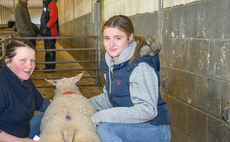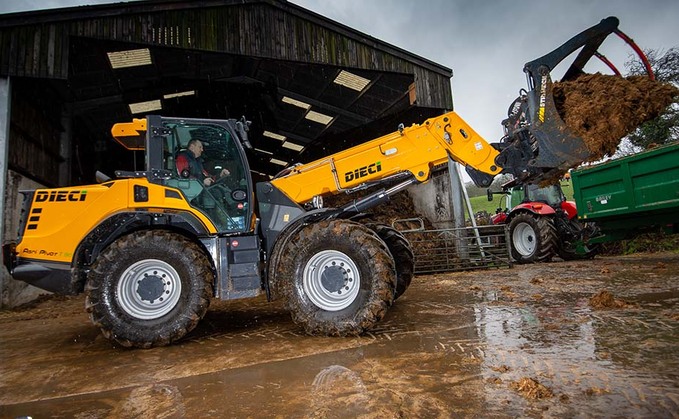
Following on from the machine's reveal at this year's LAMMA Show, we try out Dieci's latest pivot steer telehandler, the Agri Pivot T90. James Rickard finds out more with a test drive.
Representing the largest pivot steer telehandler from Dieci, the new Agri Pivot T90 comes with an impressive spec sheet. Featuring a lift capacity of 4.1 tonnes, a lift height of 5.7 metres and a 138hp engine, it certainly packs a punch on paper.
However, these figures park it firmly in the sightlines of some tough competition, such as JCB's TM420 and Schaffer's 9640T.
First seen in prototype form at the 2013 Agritechnica show, it has taken a while for the machine to come to fruition. Sharing only the cab with the rest of the Italian maker's Agri Pivot range, the rest of the T90 is new from the ground up, including chassis, boom and running gear. But has the manufacturer done enough? We aimed to find out.
Handling
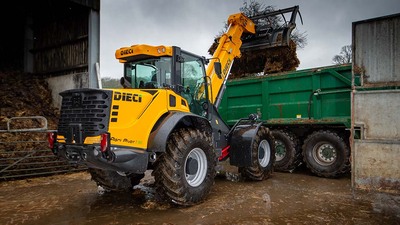
This is definitely a machine that likes to lift and get stuck in. Loader actions are not lightening quick compared to some large rigid telehandlers, but give it a few revs and it will carry out multiple loader actions with ease.
Tearout force is good, and thanks to a double ‘banana' linkage in the neck of the boom, headstock rotation is exceptional. With the boom raised at medium height, our muck grab could go from pointing straight down to pointing straight up. Granted, positioning of brackets will have an effect, but it means with materials like sticky muck, getting it out of a bucket or off a grab is much easier.
Like most modern handlers, the T90 makes use of ‘handling modes' to comply with legislation. Thankfully, the T90's are simpler and less nannying than some. On this model, a key simply switches between bucket and pallet modes. The main difference between the two is the load indicator sensors will be active all the time during pallet mode, but will be inactive in bucket mode when the boom is fully retracted. This means you get more pushing and lifting performance in bucket mode.
Should the load limit be reached, the boom can only be retracted. But if this is not enough, there is an override key which can be turned, allowing all functions to be used for 30 seconds. Impressively, during normal working conditions, mucking out and pushing up heaps, the machine's safety features rarely interfered.
Load sensors
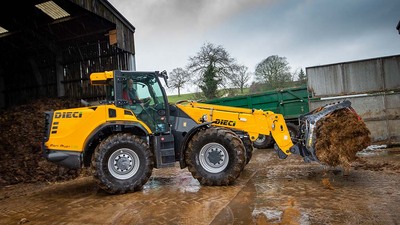
Rather than use strain gauges on the rear axle, the load indicator system on the T90 uses sensors in the main lift ram and an angle sensor on the boom to calculate how much load is being placed on the machine.
According to the manufacturer, this is a more reliable system which is far less susceptible to loss of calibration. Once this system has been calibrated, it will rarely, if at all, need doing again, it says.
The load sensors can also be used to measure loads being handled. This can be done by selecting the appropriate screen on the dash, however, the system is by no means perfect. At present, you have to set the system up every time you change attachment or start a new job - effectively like ‘zeroing' a scale. It does have a lot of potential though, for certain jobs, and if Dieci wanted to, it could prove a useful feature.
Hydraulics
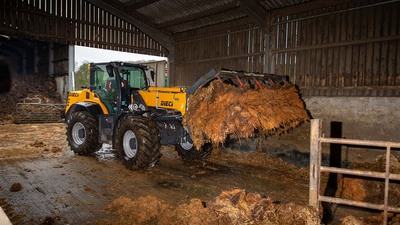
On top of the loader's main hydraulic functions, constant pumping of the third service is also a feature. Activated via button on the joystick, its flow rate during operation can also be adjusted via the third service control. Ideal for control over the flow rate of a dispenser or bedding machine.
However, while this is useful, the machine will not remember a set flow rate, so this may need adjusting every time you use it.
As well as to the headstock, third service oil flow can also be diverted to several places, using a knob on the armrest. This includes to optional services at the rear. However, there is no option of a pickup hitch at the moment, which we are told the manufacturer is working on.
For convenience, third service oil pressure can be ‘dumped', making coupling and uncoupling pipes a lot easier.
Boom and headstock
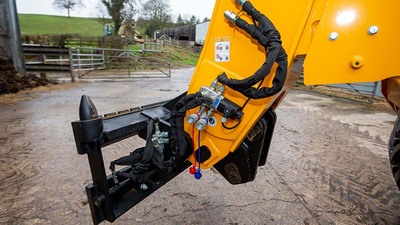
Boom suspension is a feature - always useful for ironing out bumps on a hard yard, over rutted fields or on the road.
This can be turned on or off. When on it will automatically trip out below 5kph and above a lift height of two metres. The latter can be adjusted to accommodate fertiliser bags, for example.
Overall, this gives handling accuracy when required, and increased comfort during travel. For those that are used to a more JCB TM-type centre section, which as well as turns, also pivots sideways, you might find having a rear pivoting axle a strange sensation. But it does mean the axle will follow the bumps while the cab stays upright.
Standard headstock is pin and cone, which for robustness and simplicity, you cannot beat. However, the old Matbro headstock design is starting to show its age and is rapidly nearing its limit of what it can handle. Not surprising considering what it was originally designed to lift.
The manufacturer can fit a Manitou-style headstock from the factory, and we are told a dealer should be able to fit any other type.
Transmission
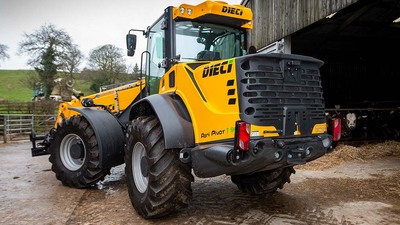
Featuring a clever transmission, the T90 has been designed to combine the best of both worlds when it comes to pushing and handling performance with high efficiency at road speeds.
For this the transmission uses one hydrostatic pump feeding one hydrostatic motor and one gear motor. At speeds below 22kph the hydrostatic motor is engaged, giving you the pushing forces and the fine control over speed required for loader work.
Above 22kph, the gear motor automatically takes over, with a clutch switching between the two. This enables higher transport speeds, allowing oil to be moved faster with less power required to do it compared to a hydro. It also has the upshot of keeping the oil that bit cooler.
The results are good too. Apart from an audible change in transmission tone, you cannot feel the change between the two hydraulic motors.
With this machine there are no range changes to select, but you can choose from one of four driving modes, selected via a dial; economy, normal, loader and cruise. Thankfully, they are all quite useful, and not just there as part of an engineering exercise.
Driving modes
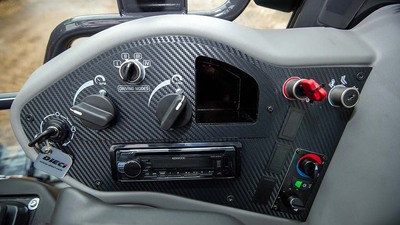
Economy mode sees the engine revs reigned in and more emphasis placed on the transmission, to ultimately save fuel. Depending on job and how you drive it, this works quite well below 30kph. Above this, the machine will resort back to needing more power to achieve 40kph.
In normal mode, full power is available all the time, while in loader mode the machine is prevented from changing up to the gear motor, effectively limiting the machine to 22kph - useful when working around the yard.
Finally, cruise mode allows you to independently set engine rpm and forward speed, using a pair of dials. When combined with a constant flow rate from the third service, it makes the machine useful at handling bedders and dispensers, for example.
Particularly in normal and loader modes, uptake of speed is swift, perhaps a little too swift in the confines of tight buildings. Maybe a de-sensitised mode could come in handy for a slightly more controlled uptake of speed - perhaps this could be a feature of loader mode, effectively giving it a virtual low range.
To get around this, the inching pedal can be used for finer control of speed, which you will find you use a lot with this machine. Reassuringly, you get a lot of engine braking with this machine, even on the road, which means the brake pedal is hardly touched.
Engine and maintenance
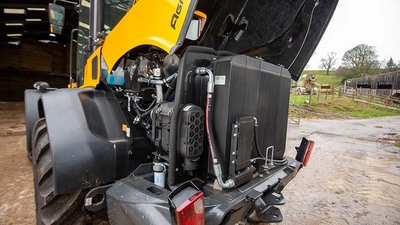
As alluded to, this is an eager machine that likes to get going, and does not take a massive amount of revs to do so. Working around the yard, this means revs can be kept relatively low. In and out of buildings during our test, we rarely hit 1,500rpm, which goes a long way to keeping noise levels down in the cab.
Power for the T90 comes from a 4.5-litre, four-cylinder FPT engine. Using only selective catalytic reduction to meet emissions, it means there is no diesel particulate filter to worry about, though you will have to top up the AdBlue tank every now and again.
Daily checks and diesel filling all has to be done with the bonnet up. It is not an insurmountable inconvenience, but when you consider the ignition key has to be used to open the bonnet and the filler cap, but the key has to remain in the bonnet to get it open, things get interesting, and a bit sweary.
Access to air filter, dipstick and header tank are decent. However, annual servicing could prove a little more challenging. While the fuel filter is conveniently placed, the engine oil filter is buried behind a menagerie of electronics and ECUs. This really needs remotely positioning somewhere else - there is space next to the fuel filter.
Under there is also the isolator switch. Again, if this was near the left hand steps, you would be inclined to use it a lot more.
Cab
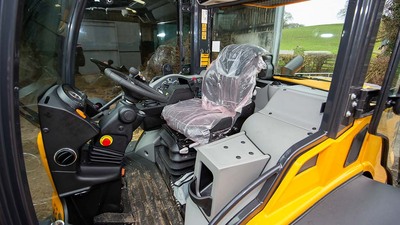
On the face of it, cab access is good, with deep, wide, grippy steps, a wide opening door and lots of grab handles to help you get on-board.
However, the door itself is one big piece of glass - not good if it gets caught in the wind. And although it can be latched fully back for convenience when hopping on and off, we would also like to see an intermediate position included, whereby the opening of the door was limited to about half way, in a very similar position to a tractor door. This would make it easier to get on and off, as the door's grab rail could be used without it moving, but it would also prevent the wind from getting hold of it.
Once in, cab space is OK. A bit more headroom and leg room would not go a miss for taller operators. More adjustment range of steering wheel and seat would be good too. As it is, the steering wheel can only move back and forth, and while the seat can slide forwards plenty far enough, it is limited as to how far back it can go.
Apart from a cubby hole large enough to accommodate a two litre drinks bottle, there is not that much storage space in the cab. And none outside.
Visibility all-round is good for the most part. A large curved windscreen and roof window help with views to the headstock throughout the lift range. The roof window could do with a wiper, but it does open for some fresh air.
At the rear, the boxy bonnet dominates sightlines, but interestingly, its square shape means it is easy enough to judge where the rear is in confined spaces.
Dotted around the cab there are lots of vents, which during our cold, wet February weather, got a thorough test, and worked well.
Controls
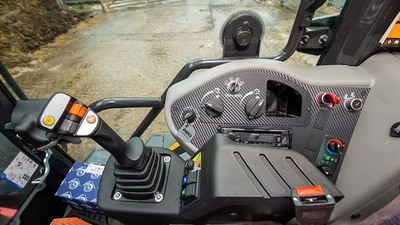
On the whole, control layout is simple and easy enough to understand. However, there is some misleading labelling of buttons; the constant pump activation button on the joystick uses a PTO symbol, the third service dump switch uses a symbol of a tipping trailer, while the rocker switch to turn on electrics to the headstock has something that looks like a jackhammer.
The joystick falls well to hand, but does not move with the seat. However, the armrest it is incorporated into does lift up out of the way, should you wish to use the right hand door. Fully electronic, all loader controls are proportional, including the third service roller switch on the back of the ‘stick and the boom in/out roller on the face. Direction control is via another switch on the face, and all roller switches are laid out well so that you can carry out multiple actions at once.
There is also the option of a left hand shuttle control. It is a retro-fit system, so if you buy the machine without it, you can fit it at a later date.
Pleasingly, there is no ‘operator presence' switch on the joystick to mess about with. Instead it uses heat sensors in the ‘stick to detect whether or not someone is actually holding it properly, or if someone has accidentally nudged it.
However, should you need to wear gloves in the winter, there is a backup button which you have to constantly keep pressed to make the joystick work.
Practicalities
Central greasing
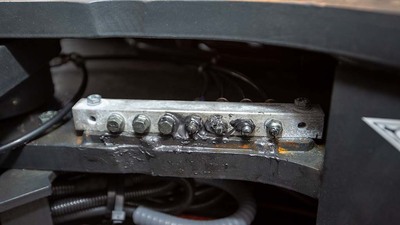
A central greasing point helps with maintenance
Steering rams
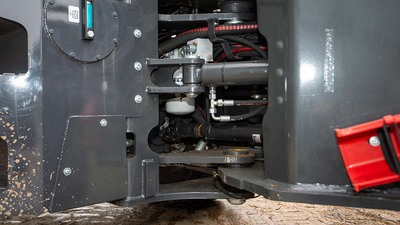
Steering rams are nice and high up, out of the muck
Lip seals
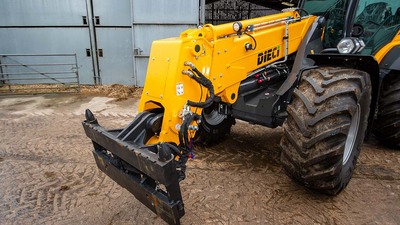
Lip seals are used on each pivot point to keep grease in and dirt out
Dash

Dash is bold, bright and easy to read at a glance
Verdict
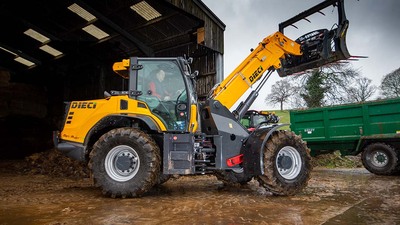
The T90 is certainly a strong performer and an eager machine to get stuck in. From its keen transmission to its impressive lift, it never left us wanting more from it during our test.
From an operation point of view, it is relatively simple with fewer interfering and confusing features compared to some competitors.
On the down side, it is silly little things like service access to the engine oil filter, a large door which is susceptible to wind attack and not enough cab space which lets it down. However, should Dieci wish to, many of these areas could be rectified to make it a better machine to live with.
Unfortunately, we cannot test for longevity of the machine, but as it is, it is definitely a loader worth considering.
Agri Pivot T90 specifications
- Engine: 4.5-litre, four-cylinder, FPT
- Power: 138hp
- Transmission: Two-stage hydrostatic with hydro and gear motors, offering 40kph
- Lift capacity: 4.1t (6.1t straight/retracted tipping load)
- Tearout force: 7,470daN
- Reach: 5.7m to bottom of pallet tines
- Hydraulic pump capacity: 150l/min
- Machine weight (no fluids): 9.5t
- Cab height: 2.8m
- Outside turning radius: 5.2m
- List price: £106,000 as tested with 540 tyres, air conditioning, air seat and boom suspension
Verdict
The T90 is certainly a strong performer and an eager machine to get stuck in. From its keen transmission to its impressive lift, it never left us wanting more from it during our test.
From an operation point of view, it is relatively simple with fewer interfering and confusing features compared to some competitors.
On the down side, it is silly little things like service access to the engine oil filter, a large door which is susceptible to wind attack and not enough cab space which lets it down. However, should Dieci wish to, many of these areas could be rectified to make it a better machine to live with.
Unfortunately, we cannot test for longevity of the machine, but as it is, it is definitely a loader worth considering.
























